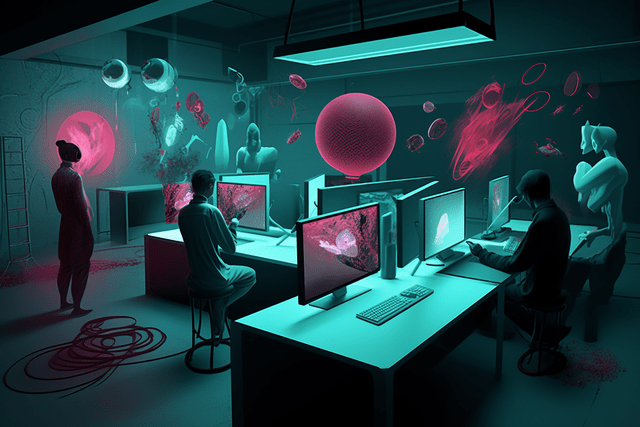Exploring the Powerful AI Design: Top Exciting Design Trends in 2023

Artificial intelligence (AI) has ingrained itself in our daily lives, transforming industries and redefining human experiences in today’s quickly changing technology landscape with Design AI . As 2023 is already here, AI design has become a significant force in driving innovation, opening up new avenues. Revolutionizing how we interact with intelligent technologies.
Table of Contents
ToggleWe’ll delve into the most exciting AI design trends of 2023 in this article. Highlighting cutting-edge innovations and ground-breaking strategies that are redefining the field of Design AI. Empowering users, and paving the way for new possibilities in the interaction between humans and AI. Prepare to learn about the influential AI design ideas that are altering the future and what is achievable.
As an AI service provider, we at ValueGiG fully understand the importance of good design in artificial intelligence. In this blog post, we will explore the art of AI design. Discuss best practices for creating effective and efficient AI systems, and highlight innovations that are shaping tomorrow’s world.
AI Designing 101: Best Practices for Creating Effective and Efficient AI
AI Designing requires a combination of creativity, technology, and a deep understanding of the problem at hand. Here are some best practices for creating AI systems that are both effective and efficient:
Define clear objectives: Establish the goals your AI system should achieve, and make sure they align with your organization’s mission and values.
Involve stakeholders: Include all relevant stakeholders, such as end-users, domain experts, and developers. In the design process to ensure a comprehensive understanding of the system’s requirements.
Focus on user experience: Design AI systems that are easy to use, intuitive, and user-friendly to improve adoption and user satisfaction.
Balance accuracy and explainability: Optimize the performance of your AI system while ensuring that its decisions are transparent, interpretable, and justifiable.
Adopt a modular and scalable approach: AI Designing your system with a modular architecture that can easily be updated, extended, or scaled to meet future needs.
Understand the Problem Domain
Before diving into the design process, it is crucial to have a deep understanding of the problem domain. This involves researching the industry, the target audience, and the specific issues that the AI system aims to address. By having a comprehensive understanding of the problem domain, designers can make informed decisions and create AI systems that genuinely address user needs.
Data Driven Design Artificial Intelligence
Data is the lifeblood of AI systems. It is essential to collect, clean, and preprocess the data that the AI system will rely on to make decisions. Designers should work closely with data scientists and domain experts to ensure that the data used for training and validation. High quality and represents the real-world scenarios that the AI system will encounter.
Design AI: How to Create Intelligent Systems That Improve the World
Our approach to AI design focuses on creating intelligent systems that have a meaningful impact on the world. We believe that well-designed AI should:
-
Enhance human capabilities: AI systems should be designed to augment human abilities and empower individuals to make better decisions. solving complex problems, and improve overall productivity.
-
Be ethical and responsible: AI design should consider ethical implications and ensure that AI systems respect user privacy. preventing bias, and promote fairness.
-
Foster collaboration and inclusivity: AI systems should be designed to encourage collaboration among users and be accessible to people of all abilities and backgrounds.
AI for Social Good
At ValueGiG, we believe in the power of AI to bring about positive change in society. We strive to create AI systems that tackle pressing global issues, such as climate change, healthcare, and education. By designing AI systems that address these challenges, we can harness the potential of AI to make a lasting, positive impact on the world.
Collaborative AI Design
Collaboration is key to designing AI systems that deliver value and resonate with users. We encourage cross-functional collaboration between designers, engineers, data scientists, and domain experts to ensure that the AI system is designed with a holistic perspective. This collaborative approach allows for the creation of AI systems that are not only technically robust but also tailored to the specific needs of users.
AI Designed for Success: The Importance of Good Design in Artificial Intelligence
Good design in artificial intelligence is crucial for several reasons:
- User adoption: AI designed systems are more likely to be embraced by users. Leading to higher adoption rates and greater overall success.
- Efficiency: A well AI designed system can streamline processes and reduce the time and resources required to complete tasks.
- Trustworthiness: Good design promotes transparency, which fosters trust in AI systems and encourages users to rely on them more confidently.
- Competitiveness: Companies that invest in AI designed systems are more likely to stay ahead of the competition and maintain a strong market position.
Continuous Improvement and Iteration
The design of AI systems is an ongoing process. As the system is deployed and used, designers should collect feedback and monitor its performance to identify areas for improvement. This feedback loop allows designers to continuously refine the AI system, making it more effective and valuable to users over time.
A I Design: The Intersection of Creativity and Technology
The intersection of creativity and technology is seen in the field of A I design. It requires knowledge of both human psychology and the specifics of AI technology. To construct systems that successfully address customer wants and expectations, successful AI designers need to be proficient in machine learning, data analysis, and user experience design.
Design Thinking’s Function in AI
An method to problem-solving called “design thinking” places a strong emphasis on experimentation, iteration, and empathy. It is a crucial component of AI design because it enables the creation of AI systems that actually appeal to consumers. Designers may better understand customer demands and create solutions that effectively answer them by integrating design thinking into the AI design process.
Artificial Intelligence Design: How to Create Smart and User-Friendly Systems
To create smart and user-friendly AI systems, designers should:
-
Understand user needs: Conduct user research and create personas to better understand the target audience and their requirements.
-
Prototype and iterate: Develop prototypes of your AI system and gather feedback from users to refine and improve the design.
-
Test and evaluate: Continuously test your AI system and evaluate its performance, making adjustments as needed to optimize its effectiveness.
-
Ensure accessibility: Design AI systems with accessibility in mind, making them usable by people with various abilities and disabilities.
-
Consider cultural context: Recognize the cultural context in which your AI system will be used and ensure that it respects local customs, values, and norms.
Designing for the Future: Innovations in AI Design That Are Shaping Tomorrow's World
AI design is an ever-evolving field, with new innovations constantly emerging. Some of the most exciting developments in AI design include:
-
Natural language processing advancements, enabling more intuitive and human-like interactions between AI systems and users.
-
Explainable AI techniques, which aim to make AI decision-making processes more transparent and understandable.
-
Personalized AI experiences, tailored to individual user preferences and needs, offering a more engaging and relevant interaction.
-
AI for social good, focusing on designing systems that address global challenges such as climate change, healthcare, and education.
-
Ethical AI design, incorporating guidelines and principles to ensure that AI systems are developed responsibly, fairly, and with respect for human values.
Conclusion
In conclusion, the topic of AI design art is fascinating and developing quickly. As an AI service provider, we are committed to developing effective, intelligent, and user-friendly AI solutions. We want to better the world through the power of well-designed artificial intelligence by adhering to best practices, emphasizing ethical and responsible design, and remaining at the forefront of AI developments.
We can harness the revolutionary potential of AI and build a better future for everybody via collaboration, empathy, and continual development.















